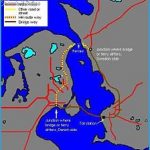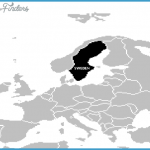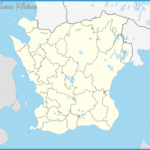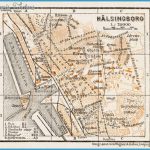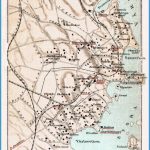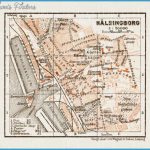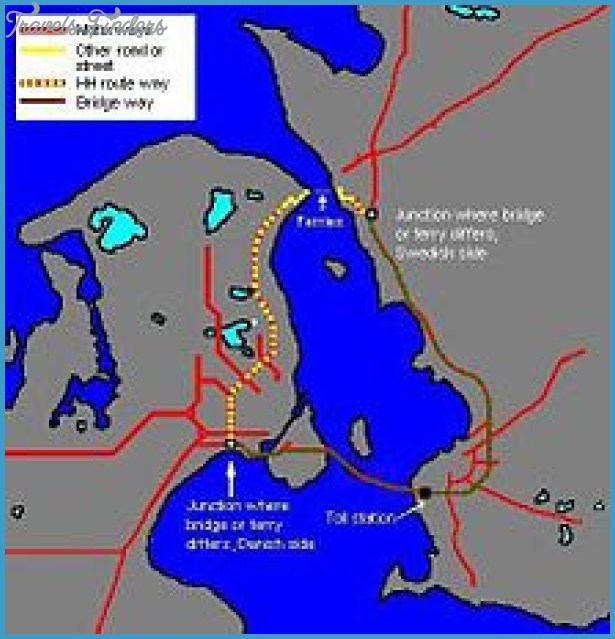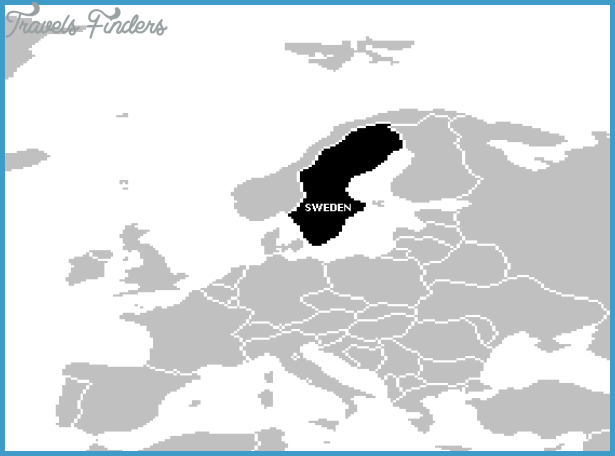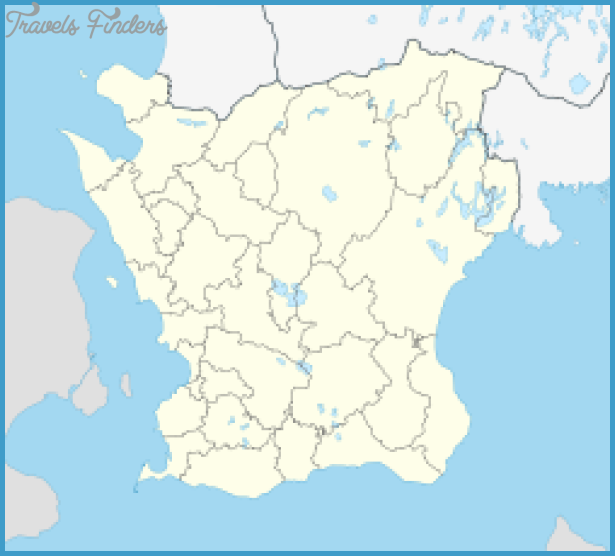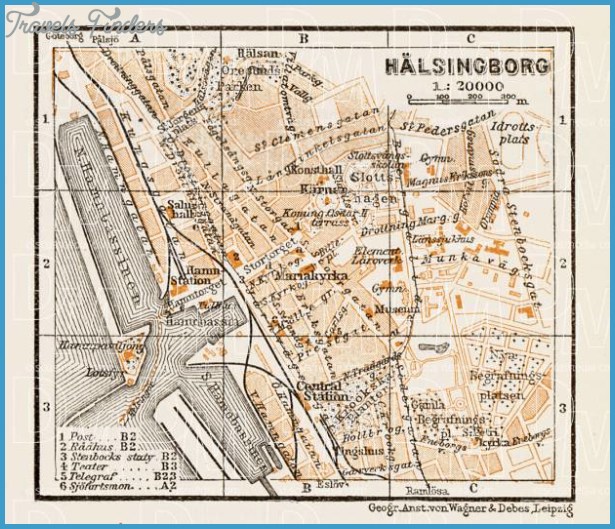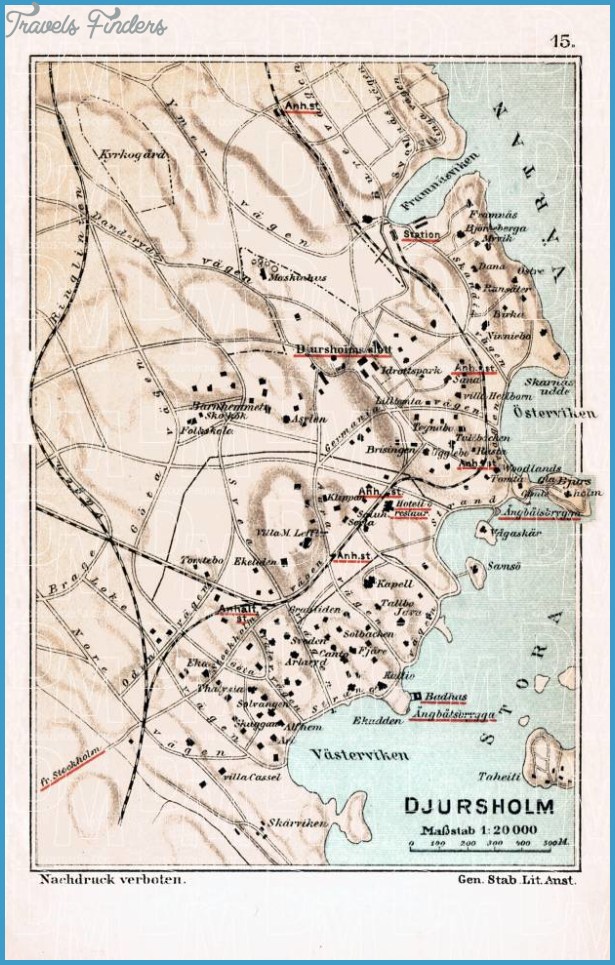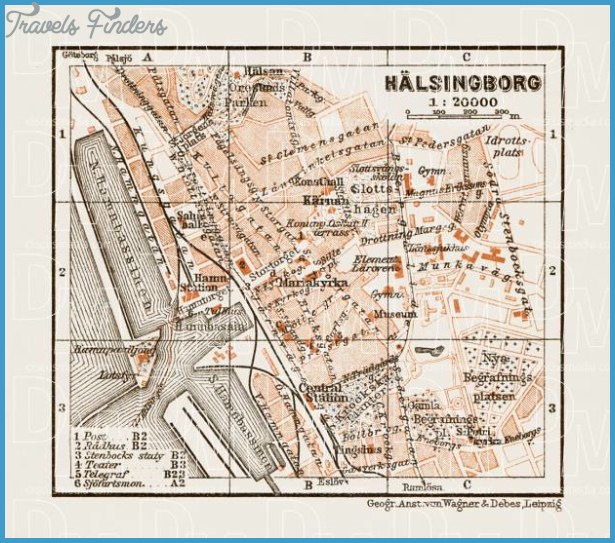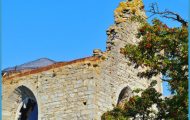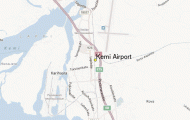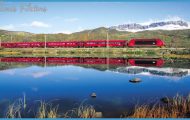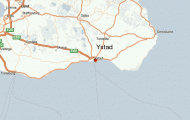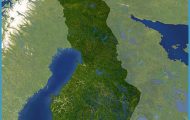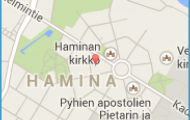HOTELS. Grand, Stortorget 8-12, 200 Karnan, Jarnvagsgatan 17, 94 Helsingborg, Stortorget, 120
Hogvakten, Stortorget 14, 104 Esso Motor Hotel, Florettgatan 41, 369 SB; MHF-Motellet Tre Hastar, Angelholmsvagen 35, 140 Molberg, Stortorget 18, 110 Savoy, Prastgatan 10, 100 Viking, Fagelsangsgatan 1, 50 Fralsingsarmens Hotell Anglais (Salvation Army), Gustaf Adolfs Gata
SIGHTS. Visitors arriving in Helsingborg from Helsingpr, on the Danish side of the Oresund (frequent services), are immediately confronted by the town’s principal landmark, a prominent brick tower 35 m (11 5 ft) high. It is known as Karnan and stands at the upper end of the long market square, Stortorg. From here a broad flight of steps flanked by two towers (elevator (lift) in the left-hand tower) leads up to Konung Oscar H.s Terrass (terrace restaurant). There stands the old defensive tower, with foundations up to 4i m thick and a circumference of 60 m (200 ft). It was the central feature of a stronghold built by Valdemar Atterdag (1 340-75) on the site of an earlier timber fortress which probably dated from the 10th c. and was destroyed in 1680 with the exception of the tower. From the top of the tower (190 steps) there are
The Swedish town of Helsingborg (Halsingborg in Swedish), in a strategic position at the narrowest part of the Oresund, was for centuries hotly disputed between Denmark and Sweden. First mentioned in the records in 1085, the town received its municipal charter in 1649. It is now a busy port, commercial and industrial town, and Sweden’s main channel of communication with Denmark by sea.
Fredriksdal Sports Stadium magnificent views of the town, the Sound and Denmark. At the lower end of the market square is a statue (by J. Borjesson) ofthe Swedish general Count Magnus Stenbock (1 664-1 71 7), erected in 1 901 to commemorate his victory over the Danes N of Helsingborg in 1710. Opposite it is the Neo-Gothic Town Hall (1 897;tower70m (230ft) high);stained-glass windows depicting events in the history of the town. In front of the Town Hall are Norwegian and Danish memorial stones commemorating the assistance given by Sweden during the German occupation in the Second World War.
SW of the Stortorg, adjoining the ferry port, is the Hamntorg (Harbour Square), with the Seafarers’ Monument, a column topped by a figure of Mercury (C. Milles). Close by is a modest memorial commemorating the arrival of the French marshal Jean-Baptiste Bernadotte in 1810. He had been chosen by the Swedish Parliament as heir to the throne and adopted by the childless king Karl III; he became king as Karl Johan XIV in 1818.
At the upper end of the Stortorg Norra Storgatan bears to the left, and at No. 21 is Helsingborg’s oldest private house, Jakob Hansens Hus (1641; restored 1931), a handsome half-timbered building. In front of it is a fountain topped by a celestial sphere (1927) commemorating the astronomer Tycho Brahe. In Sodra Storgatan, which runs S from the end of the Stortorg, stands the Gothic St Mary’s Church (Mariakyrkan, 13th c„ reconstructed in 1 5th c.), with a beautiful reredos (ornamental altar screen) (c. 1450), a splendid pulpit of 1615 and a chart outlining historical records from 900 to modern times. Farther S (No. 31) the Municipal Museum contains an extensive collection, including an art gallery; to the rear is an open-air section ofthe museum.
Jarnvagsgatan, which runs SE from the near end of the Stortorg, passes the Municipal Library (1 965) and the Station. Drottningatan leads N W from the Stortorg to St Jorgens Plats, where one can see sculpture by A. Wallenberg, Youth at Play. On the W side ofthe square we find the Concert Hall (Konserthuset: by Sven Markelius, 1932), and behind this the Municipal Theatre (1976). To the NE extends the Oresund Park, in which there is an old spa, Halsan. On the other side of Halsovagen, in Vikingberg Park, is the Museum of Art (Konstmuseet) which houses a collection of both old and modern art (including Frans Hals’s portrait of Descartes). Tothe rear of Karnan extends the beautiful park of Slottshagen, with a sculpture by C. Eriksson, The Hunt, and remains of the old castle. To the N E is Stenbocksgatan and beyond this the Fredriksdal Open-Air Museum, with a manor-house (1787), various old buildings, a Music Museum, a Botanic Garden and an open-air theatre. In Stenbocksgatan itself is the Sports Stadium (Idrottens Hus), with seating for 5000.
SURROUNDINGS. 4 km (24 miles) SE is the well-known spa of Ramlosa Brunn (established 1707). In Sweden Ramlosa is not merely a brand name but has practically become a synonym for mineral water. Strandvagen runs NW along the coast past a number of seaside places and the Pasjd Skog nature reserve (small 17th c. castle; the Thalassa guest-house). In 5 km (3 miles) the road comes to Sofiero Castle, built for Princess Sofie in 1865 by Prince Oscar, later Oscar II. In 1 905 it passed to Prince, later King Gustav VI Adolf, grandfather of the present king, as a wedding present, and became the favourite summer residence both of the king and of his second wife, Louise, sister of Earl Mountbatten. The old king was an enthusiastic rhododendron grower, and the castle has a collection of over 500 varieties. After his death in 1 973, the castle became the property of the town of Helsingborg.
Helsingborg to Molle and Kullen: an attractive trip of 31 km (20 miles). Leave on Strandvagen (Road 22), which runs along the coast, passing Palsjo and Sofiero Castle. At the residential suburb of Laroda short detour can be made to the resort of Hittorp (to left). 8 km (5 miles) from Helsingborg, to the left of the road, stands Kulla Gunnarstorp Castle (1865-78), in Dutch Renaissance style. Nearby is an old fortified castle, with ramparts and moats. In the park is the largest beech tree in SkSne, 6 m (20 ft) in circumference. 6 km (4 miles): Viken, an old fishing village which is now a holiday resort. The road continues along the Oresund, and after 6 km reaches the town of Hoganas (pop. 22,000), famous for its pottery industry. It then runs past the seaside resorts of Strandbaden and Nyhamnslage. 10 km (6 miles) beyond Hoganas, on the left, is Krapperup Castle (1790), with remains of a fortified castle and a large plantation of rhododendrons. Soon after this, the Kullen promontory appears. 3 km (2 miles): Molle (Grand Hotel, 100 Kullaberg Hotell, 27 Turisthotellet, 27 b.), a small but very popular holiday town at the foot of the Kullen hills (no sandy beach).
Kullen is a 1 5 km (9 mile) long promontory reaching out into the Kattegat, formed by the sinking of the surrounding land. The round-topped hills, worn smooth by the action of ice, support a variety of vegetation. At many points the hills fall steeply to the sea and have been heavily indented by the waves. The highest point on this peninsula between the Oresund and Skaldervik is Hogkufl (188 m 617 ft). Many footpaths; golf-course; deer-park. The NW part ofthe promontory is a nature reserve. From Molle a road (4 km (2 miles): toll) climbs past the farm of Kullagard to the tip of the promontory. Here is the highest lighthouse in Europe (74 m (243 ft) above sea level), standing since 1 561. The present light, installed in 1900, has a range of 43 km (27 miles). Magnificent view of the Kattegat. Along the coasts of the promontory are many caves, among them the Silver Cave (Silvergrottan) and the Stone Huts (Stens-tugorna) on the S side, and the Josefinelust and Djupadal caves on the N. 7 km (4 miles) E of Molle, on the S side of the Skaldervik, is the idyllic fishing village and holiday resort of Aritd (RusthailargSrden Hotel, 45 Strand Hotell, 30 b.)
To reach Angelholm from Molle, return 3 km (2 miles) along Road 22 to Molehassle and turn left into a minor road which leads past Brunnby church (dating in part from the 12th c.) to Tunneberga, then on Road 112, past Vegeholm Castle (1 6th c.), set in a large and beautiful park on an island in the VegeS (two square towers), to Angelholm (31 km (19 miles): Continental Hotel, 40 Angelholm Motel, 30 b.): Old Town Hall (17th c.), local museum.
Helsingborg to Landskrona. The road (with the E6 motorway (highway) running parallel) passes the spa of Ramlosa Brunn and the fishing village and seaside resort of Raa. It then cuts through a range of low hills (beautiful view ofthe Sound, with the island of Ven) to Gumsdv (Orenas Slott Hotel, 225 SP) where there is a Carmelite nunnery established in 1961-2 (the first Catholic nunnery in Sweden since the Reformation). 22 km (14 miles) from Helsingborg is Landskrona (pop. 34,000; Oresund Hotel, 100 b.), a busy port and industrial town on the Oresund, with a 16th c. castle (extensive fortifications), a Provincial Museum and an Art Gallery. While working as a teacher here (1885-97), Selma Lagerlof wrote her novel Gosta Berling. Ferry service overthe Oresund to Copenhagen (lhours). There is also a boat service to the Swedish island of Ven (area 7-5 sq. km 3 sq. miles), in the Sound. On the W side of the island is Backviken, where the boat docks. Near the 13th c. St Ibb’s Church are the sparse remains of the observatory of Uranienborg, built in 1 576 by the astronomer Tycho Brahe (1 546-1 601); small museum.

